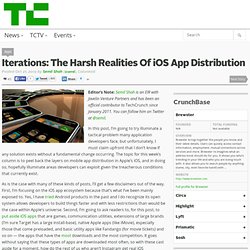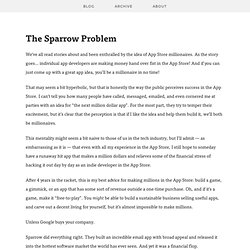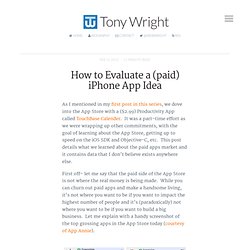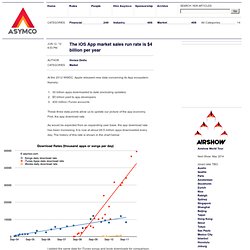

Iterations: The Harsh Realities Of iOS App Distribution. Editor’s Note: Semil Shah is an EIR with Javelin Venture Partners and has been an official contributor to TechCrunch since January 2011.

You can follow him on Twitter at @semil. In this post, I’m going to try illuminate a tactical problem many application developers face, but unfortunately, I must claim upfront that I don’t know if any solution exists without a fundamental change occurring. The topic for this week’s column is to peel back the layers on mobile app distribution in Apple’s iOS, and in doing so, hopefully illuminate areas developers can exploit given the treacherous conditions that currently exist. As is the case with many of these kinds of posts, I’ll get a few disclaimers out of the way. First, I’m focusing on the iOS app ecosystem because that’s what I’ve been mainly exposed to. The short answer is: I’m afraid, at least right now, for many it feels like an unattainable goal. It took some time to arrive at this conclusion. TinyCo Launches Revenue Sharing Program For Mobile Game Developers. How bad is the fight to get more users in mobile apps?

Tough enough that TinyCo, an Andreessen Horowitz-backed mobile gaming company, is doing a revenue share with developers that successfully drive them traffic. The company, which has raised $18 million, says it will give developers a 50 percent split or more if they send them customers that ultimately end up spending inside of their games.
Developers can drive up the revenue share in their favor if they do special integrations that really promote TinyCo’s work. An example is Fluik’s game Office Jerk, where the company actually lets players throw an egg at their annoying co-worker instead of a stapler or a roll of toilet paper. App Cubby Blog - The Sparrow Problem. We’ve all read stories about and been enthralled by the idea of App Store millionaires.

As the story goes… individual app developers are making money hand over fist in the App Store! And if you can just come up with a great app idea, you’ll be a millionaire in no time! That may seem a bit hyperbolic, but that is honestly the way the public perceives success in the App Store. I can’t tell you how many people have called, messaged, emailed, and even cornered me at parties with an idea for “the next million dollar app”.
For the most part, they try to temper their excitement, but it’s clear that the perception is that if I like the idea and help them build it, we’ll both be millionaires. After 4 years in the racket, this is my best advice for making millions in the App Store: build a game, a gimmick, or an app that has some sort of revenue outside a one-time purchase. Unless Google buys your company. Sparrow did everything right. Flop? Chart generated at appannie.com And Launch Center Pro: How to Evaluate a (paid) iPhone App Idea - Tony Wright's Startup Front-End - As I mentioned in my first post in this series, we dove into the App Store with a ($2.99) Productivity App called TouchBase Calender.

It was a part-time effort as we were wrapping up other commitments, with the goal of learning about the App Store, getting up to speed on the iOS SDK and Objective-C, etc. This post details what we learned about the paid apps market and it contains data that I don’t believe exists anywhere else. First off– let me say that the paid side of the App Store is not where the real money is being made. While you can churn out paid apps and make a handsome living, it’s not where you want to be if you want to impact the highest number of people and it’s (paradoxically) not where you want to be if you want to build a big business.
Let me explain with a handy screenshot of the top grossing apps in the App Store today (courtesy of App Annie). Apps with a blue-ish background are free apps. The iOS App market sales run rate is $4 billion per year. At the 2012 WWDC, Apple released new data concerning its App ecosystem.

Namely: 30 billion apps downloaded to date (excluding updates)$5 billion paid to app developers400 million iTunes accounts These three data points allow us to update our picture of the app economy. First, the app download rate. As would be expected from an expanding user base, the app download rate has been increasing. I added the same data for iTunes songs and book downloads for comparison.
In terms of total, cumulative downloads, the comparison is even more stark: It won’t be long before total app downloads will be double total song downloads. On average, songs are more expensive than apps ($1.29 vs. $0.24). The data shows that apps have very likely overtaken songs as “gross” income. What about consumption? Here again apps show a distinctive pattern of out-performing songs. What about pricing?
No. Finally, how about the content owners? Developers still have a long way to go.